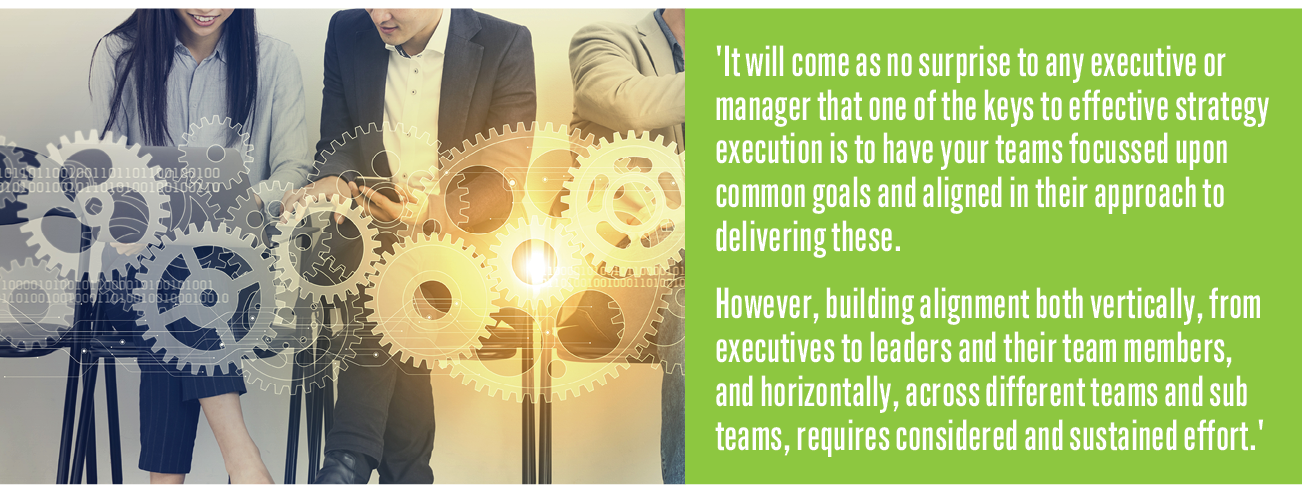Enhancing effectiveness through improved vertical and horizontal team alignment
by Zoe Pappas & Jess Cossens
Right Thinking
An organisation’s effectiveness is fundamentally dependent upon the alignment within and between the teams on the frontline. As Patrick Lencioni puts it, ‘if you could get all the people in an organisation rowing in the same direction, you could dominate any industry, in any market, against any competition, at any time’ (Lencioni 2002).
There are five practical steps you can take to improve vertical and horizontal team alignment:
- Develop clear departmental strategies that support the enterprise
- Align accountabilities and priorities of leaders and teams
- Establish principles for collaboration
- Manage ‘boundary stakeholders’
- Make the ‘real work’ fun.
 In 1085, the British Navy, commanded by Admiral Horatio Nelson won a consummate victory against a numerically superior Franco-Spanish force at the Battle of Trafalgar. Historians widely attribute this victory to two factors. Firstly, Nelson’s tactic of ‘breaking the line’ represented a disruptive strategy innovation, to which his opponents were unprepared to respond. Secondly, the British Navy, having spent the proceeding two years at sea blockading the French and Spanish fleets in their ports, had reached a pinnacle of operational effectiveness. Nelson had a brilliant strategy, but without the high degree of alignment within Nelson’s fleet, this strategy could not have been executed so effectively.
In 1085, the British Navy, commanded by Admiral Horatio Nelson won a consummate victory against a numerically superior Franco-Spanish force at the Battle of Trafalgar. Historians widely attribute this victory to two factors. Firstly, Nelson’s tactic of ‘breaking the line’ represented a disruptive strategy innovation, to which his opponents were unprepared to respond. Secondly, the British Navy, having spent the proceeding two years at sea blockading the French and Spanish fleets in their ports, had reached a pinnacle of operational effectiveness. Nelson had a brilliant strategy, but without the high degree of alignment within Nelson’s fleet, this strategy could not have been executed so effectively.
A strategy is only as good as the team charged with delivering it. It will come as no surprise to any executive or manager that one of the keys to effective strategy execution is to have your teams focussed upon common goals and aligned in their approach to delivering these. However, building alignment both vertically, from executives to leaders and their team members, and horizontally, across different teams and sub teams, requires considered and sustained effort. We have identified five actions which will help make sure your team is working together effectively towards delivering your organisation’s strategy.
1. Develop a department strategy that supports the enterprise
Generally, higher-level employees will feel they have a solid understanding of the organisation’s strategy and key objectives, and will recognise where and how they can contribute to these. This is a great start. However, this awareness often dilutes further down in the organisation (Galunic & Hermreck 2012). To combat this, Heads of Department should develop their own departmental strategies to bring the enterprise strategy to life for their team.
This process is two-fold. Firstly, there must be a clear communication of the enterprise strategy and an explanation of how this department is expected to contribute to it. Where possible, this communication should be from a representative of the executive, ideally the CEO, who will be able to explain the strategy with the level of passion and clarity required to motivate the team (Galunic & Hermreck 2012).
The second step is a lot more challenging, developing a department-level strategy that will enable delivery of the enterprise strategy. For example, we frequently work with support services departments to help them understand where they can add greatest value at the enterprise level, and then translate this into fundamental goals they must achieve over the next year. The departmental strategy must clearly articulate not only what goals the department is seeking to achieve, but also how it will measure its success and how achievement of these goals will support the enterprise strategy (Gallo 2010). Providing this level of clarity at the department level empowers individuals to directly see the contribution of their work as it flows up into the wider organisation.
2. Align leadership accountabilities and individual priorities
Once a departmental strategy has been defined, it is important to align priorities and accountabilities at an individual level. We often recommend the following simple framework to assist with this (Bregman 2013). The process begins with the Head of Department who will share their top five priorities for the next twelve months. These priorities should align closely with the fundamental goals laid out in the departmental strategy.
The Head of Department’s direct reports then share their top five priorities for the same period. The group can then check for alignment across this level of the team. Is the Head of Department receiving enough support for all her priorities? Is there unnecessary overlap between general managers in certain areas? This exercise can be repeated with each subsequent layer of the department until all staff are represented and a full priority map is formed. In addition to aligning priorities across the department, this exercise also highlights opportunities for intra-departmental collaboration.
3. Establish principles for collaborative ways of working
Depending on the maturity of your team, establishing clear expectations for how the team will work together can be a crucial step. Are you engaging a new team figuring out their forming stage, a team struggling through storming, or a norming team striving to perform (Tuckman 1965)? High performing teams demonstrate high levels of trust, are comfortable with constructive conflict, show strong levels of commitment, hold each other to account and are results oriented (Lencioni 2002).
While for mature teams these expectations might be well understood, newer teams, or even established teams who are failing to thrive, can benefit significantly from making these expectations explicit. Having a candid conversation and agreeing principles for how your department will work together provides a framework to guide individuals through any intra-departmental challenges that may arise.
4. Manage ‘boundary stakeholders’
In the workplaces of today, few teams work in isolation. In fact, helping move teams away from siloed operations is a request we hear from clients almost weekly. To promote effective collaboration beyond the departmental borders we recommend developing strategies to manage your ‘boundary stakeholders’.
Boundary stakeholders refer to those with whom your team interacts on a regular basis to perform their day-to-day work and collaborates with to deliver cross-functional projects. They can include other departments within your organisation, as well as external service providers or other partners. To truly enable your team to perform at its best it is important to identify who your critical boundary stakeholders are and to manage their needs accordingly. In some cases, this may be as simple as developing a communications plan to ensure other departments understand your team’s refreshed priorities.
In other circumstances, a more defined partnership alignment strategy may be required to formalise how these teams will work together. Some of our clients have used Robert Kaplan and David Norton’s strategy maps to manage internal and external alliances (Kaplan & Norton 1998).
This involves identifying ‘wins’ for each party, and common ‘wins’, along with desired customer outcomes stemming from the alliance, joint business processes, ways of working and values of the alliance.
5. Do some real work … but make it fun
One final piece of the puzzle, not to be overlooked, is the importance of making team alignment sessions that are part of this effort fun and engaging. We have found enormous value in incorporating some light-hearted team bonding throughout the sessions, offering participants a chance to connect with their teammates on a personal level, share a few jokes and enjoy each other’s company. These activities should not be entirely frivolous. You can get small cross-functional groups working on an organisation’s real challenge, but add a creative twist. For example, during a workshop for a client that was considering moving to new premises, we asked the participants to work together to build physical models of their future office. Not only do these interactive sessions build greater team cohesion, but the fun can act as a trigger for improved memory retention (Gilkey & Kilts 2007).
***
After a team alignment process, it is important to establish mechanisms to maintain the change; for example, by bringing the team together regularly to address any friction points. And, of course, it is important to recognise the team’s achievements and celebrate its successes along the way. Quarterly team catch ups incorporating progress reviews and social time are an effective way to do this.
Promoting alignment requires both discipline and habit. In the nineteenth century the Royal Navy accomplished this through a combination of corporal punishment and institutionalised alcoholism. Thankfully modern leaders need not resort to such extreme measures to foster alignment within their organisations! Instead, leaders can greatly improve the horizontal and vertical alignment within and between teams by stepping through the activities outlined in this article. Whether you’re working with a newly formed team, or one that has been delivering for many years, most teams can benefit from taking the time to reflect upon and enhance their alignment, to ensure they are working effectively towards the goals that matter most.
References
Bregman, P 2013, ‘A personal approach to organisational time management’, McKinsey Quarterly, January.
Gallo, A 2010, ‘Making your strategy work on the frontline’, Harvard Business Review, June.
Galunic, C & Hermreck, I 2012, ‘How to help employees “get” strategy’, Harvard Business Review, December.
Gilkey, R & Kilts, C 2007, ‘Cognitive fitness’, Harvard Business Review, November.
Kaplan, R & Norton, D 1996, ‘The Balanced Scorecard: Translating strategy into action’, Harvard Business Review Press, Boston, US.
Lencioni, P 2002, ‘The five dysfunctions of a team:
A leadership fable’, Jossey-Bass, 2002.
Tuckman, B 1965. ‘Developmental sequence in small groups’, Psychological Bulletin. 63 (6): 384–399.
© 2018 Right Lane Consulting
We hope the ideas presented here have given you something new to think about. We would love the opportunity to discuss them with you in more detail. Get in touch today.


